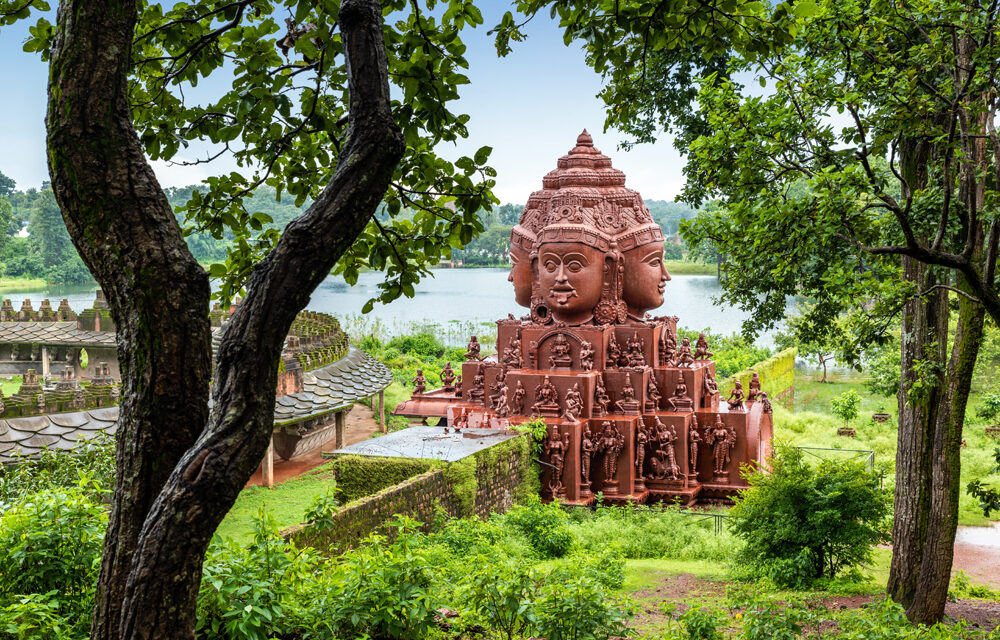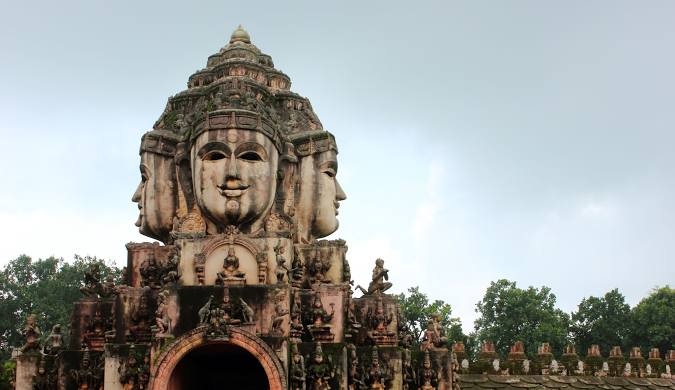Amarkantak: The Sacred Hill Station of Central India
Introduction

Amarkantak, often referred to as the “Teerthraj” (King of Pilgrimage Sites), is a sacred town nestled in the Vindhya and Satpura mountain ranges in Madhya Pradesh, India. It is the origin of the holy Narmada River, which holds immense spiritual and cultural significance. The town is surrounded by dense forests, serene waterfalls, and ancient temples, making it a perfect destination for pilgrims, nature lovers, and history enthusiasts alike.
Amarkantak is not just a religious hub but also an important ecological hotspot, with its rich biodiversity and lush greenery providing a tranquil retreat for visitors. The region is dotted with sacred ponds, majestic peaks, and spiritual hermitages, where saints and sages have meditated for centuries. The confluence of spirituality, mythology, and natural beauty makes Amarkantak a unique and mesmerizing destination.
Due to its mythological connections and religious importance, Amarkantak attracts thousands of devotees throughout the year, especially during major Hindu festivals like Maha Shivaratri and Narmada Jayanti. The town’s heritage and architectural marvels reflect the influence of various dynasties, including the Kalachuris, Baghels, and Marathas, who contributed significantly to its temple constructions and cultural landscape.
With its cool climate, rich history, and sacred ambiance, Amarkantak is an ideal place for spiritual rejuvenation, meditation, and nature exploration. Whether one seeks divine blessings, scenic beauty, or historical insights, Amarkantak promises an unforgettable experience.
Geographical Significance of Amarkantak
Amarkantak is a geographically unique and culturally significant location in central India, known for its elevated terrain, rich biodiversity, and the confluence of major mountain ranges. It holds immense importance as the source of three major rivers and serves as a natural wonder with its pristine landscapes, dense forests, and sacred sites.
1. Elevation and Climate
Amarkantak is situated at an elevation of approximately 1,048 meters (3,438 feet) above sea level, making it a hill station with a cool and pleasant climate throughout the year.
- Mild Summers (March to June): Temperatures range between 18°C and 30°C, offering a refreshing retreat from the scorching heat of the plains.
- Monsoon (July to September): The region receives moderate to heavy rainfall, enhancing its lush greenery and creating stunning waterfalls.
- Chilly Winters (October to February): Temperatures can drop to as low as 4°C to 10°C, making it a perfect destination for those who enjoy winter landscapes and misty mornings.
The serene weather, fresh mountain air, and scenic beauty make Amarkantak a favored destination for spiritual seekers, nature lovers, and adventure enthusiasts.
2. A Unique Geomorphological Location
Amarkantak holds a strategic position as the meeting point of three major mountain ranges:
🏔 Vindhya Range – A historic and geologically significant range forming the northern boundary of the Narmada Valley.
🏔 Satpura Range – Known for its dense forests, rich biodiversity, and deep river valleys, contributing to the region’s ecological wealth.
🏔 Maikal Hills – An extension of the Satpura range, providing rugged terrains, waterfalls, and dense vegetation, making it a paradise for trekkers and explorers.
This unique geographical setting makes Amarkantak a biodiversity hotspot, home to medicinal plants, rare flora, and diverse wildlife, and offers breathtaking views of the surrounding hills and valleys.
3. Source of Three Major Rivers
Amarkantak is often referred to as the “Teerthraj” (King of Pilgrimage Sites) due to its religious importance and its role as the origin point of three significant rivers.
1. Narmada River – The Lifeline of Central India
- The Narmada River, one of the seven holiest rivers in India, originates from Narmada Kund, a revered site in Amarkantak.
- It is considered eternal and sacred in Hindu tradition, often worshipped as a goddess.
- Flowing westward, it covers a journey of 1,312 km before emptying into the Arabian Sea.
- The river is renowned for its scenic ghats, ancient temples, and spiritual significance, attracting pilgrims and tourists alike.
2. Son River – A Major Tributary of the Ganges
- The Son River originates from Sonmuda, a picturesque point in Amarkantak.
- Unlike the Narmada, the Son flows eastward, covering a distance of 784 km before joining the Ganges River in Bihar.
- The Son River valley is known for its fertile plains and historic settlements along its banks.
3. Johila River – A Regional Waterway of Significance
- The Johila River is a lesser-known but locally significant river that also originates from the Amarkantak plateau.
- It serves as a crucial water source for nearby villages and plays an important role in the local ecosystem and agriculture.
The presence of these three rivers originating from a single location makes Amarkantak an exceptionally rare hydro-geographical phenomenon, adding to its spiritual and ecological importance.
4. Rich Biodiversity and Ecological Importance
Amarkantak is surrounded by dense forests, waterfalls, and diverse wildlife, making it an ecological treasure trove.
🌿 Flora: The region is home to rare medicinal plants and herbs, some of which are used in Ayurvedic treatments. The forests consist of Sal, Teak, Bamboo, and Mahua trees, contributing to the area’s green cover.
🐆 Fauna: The surrounding forests are home to wildlife such as leopards, bears, deer, langurs, wild boars, and various species of birds. The Melghat and Achanakmar Wildlife Sanctuaries, located nearby, help in conservation efforts for endangered species.
The combination of high-altitude forests, river valleys, and unique geography makes Amarkantak an important site for environmental studies, conservation projects, and eco-tourism.
5. Geological and Historical Importance
- Amarkantak’s plateau is geologically significant, consisting of ancient volcanic rocks and sedimentary formations, indicating that the area was shaped by tectonic and erosional forces over millions of years.
- The region has been mentioned in Hindu scriptures, epics like the Mahabharata, and various Puranas, adding to its historical and mythological importance.
- Archaeological evidence suggests that Amarkantak has been an ancient pilgrimage site for thousands of years, with historical temples and monuments still standing today.
Historical and Mythological Significance of Amarkantak
Amarkantak holds immense historical and mythological importance, making it a revered site in Indian traditions. It has been mentioned in various ancient scriptures, including the Puranas, Ramayana, and Mahabharata, emphasizing its deep-rooted connection to Hinduism and its association with sages, deities, and legendary rulers.
Mythological Significance
-
Sage Kapila’s Meditation
Amarkantak is believed to be the meditative abode of Sage Kapila, a revered ascetic in Hindu mythology. His spiritual practices in this sacred land have contributed to Amarkantak’s reputation as a center for enlightenment and divine wisdom. -
The Sacred Narmada River
The Narmada River, originating from Amarkantak, is considered one of the holiest rivers in Hinduism, even older than the Ganges. According to legend, a dip in its waters can purify the soul and wash away sins, making it a crucial pilgrimage site for devotees. -
Lord Shiva’s Boon to Narmada
Mythology states that Lord Shiva granted a boon to the Narmada River, allowing her to flow freely and bless the land with fertility and prosperity. This divine connection enhances the spiritual significance of Amarkantak and the rituals performed along the riverbanks. -
The Pandavas’ Visit
According to the Mahabharata, the Pandavas spent time in Amarkantak during their exile (vanavasa). The forests and riverbanks of this region provided them refuge, and local traditions claim that they performed rituals and prayers here.
Historical Significance
-
Ancient Kingdoms and Dynasties
Amarkantak has been an important site for various dynasties, including the Kalachuris, Baghels, and Marathas. These rulers contributed significantly to the region’s development by constructing temples, ghats, and religious monuments. -
Kalachuri Dynasty’s Contributions
The Kalachuri rulers, especially King Karnadeva, played a vital role in shaping Amarkantak’s architectural and religious landscape. They built several temples, including the famous Karna Mandir, which stands as a testament to their patronage. -
Baghel and Maratha Influence
The Baghel rulers of Rewa and the Marathas also contributed to the preservation of Amarkantak’s temples and spiritual sites. They maintained the region’s cultural heritage and helped establish it as a major pilgrimage center. -
Influence of Saints and Sages
Over the centuries, Amarkantak has attracted many saints and spiritual leaders who sought enlightenment in its serene environment. Figures like Adi Shankaracharya are believed to have visited the region, further elevating its religious importance.
Major Attractions in Amarkantak
Amarkantak, often referred to as the “King of Pilgrimages”, is home to several sacred temples, breathtaking waterfalls, and natural wonders. Each attraction in this holy town is steeped in history, mythology, and natural beauty, making it a must-visit destination for pilgrims, history enthusiasts, and nature lovers alike.
1. Narmada Udgam Kund – The Sacred Source of the Narmada River
The Narmada Udgam Kund marks the divine origin of the Narmada River, one of the holiest rivers in India. This sacred pond is housed within a beautifully constructed temple complex, where devotees gather to offer prayers, take a holy dip, and seek blessings.
- The temple, dedicated to Goddess Narmada, features intricately carved pillars, domes, and religious inscriptions.
- Pilgrims believe that bathing in the kund washes away sins and grants spiritual liberation.
- The complex is surrounded by smaller temples dedicated to various Hindu deities, adding to its religious significance.
2. Shri Yantra Mandir – A Unique Symbol of Cosmic Energy
One of the most architecturally fascinating temples in Amarkantak, the Shri Yantra Mandir is a spiritual marvel built by the Shankaracharya of Kanchi.
- The temple is designed in the form of a Shri Yantra, a mystical geometrical structure that symbolizes the cosmic energy of the universe.
- Devotees visit this temple to meditate and harness the spiritual vibrations of the Shri Yantra.
- The intricate carvings and celestial alignments of the temple make it a blend of devotion, architecture, and ancient knowledge.
3. Ancient Temples of the Kalachuri Era – A Testament to Architectural Brilliance
Dating back to the 10th and 11th centuries, these temples were built by the Kalachuri dynasty, known for their exquisite temple architecture.
- Among the most famous are:
- Pataleshwar Mahadev Temple, dedicated to Lord Shiva, with a unique underground sanctum symbolizing the lord’s connection to the underworld.
- Machhendranath Temple, which houses idols of Hindu deities and showcases intricate stone carvings.
- These temples stand as a testament to the artistic and architectural mastery of the Kalachuris and attract history buffs and spiritual seekers alike.
4. Dudh Dhara Waterfall – A Milky White Wonder
Located a few kilometers from Amarkantak, Dudh Dhara Waterfall is named after its milky white waters, resembling flowing milk.
- The waterfall, surrounded by dense forests, is a serene spot for visitors looking to relax, meditate, or enjoy nature’s beauty.
- The legend states that Saint Durvasa, known for his intense penance, meditated near this waterfall.
- The cool and pristine waters offer a refreshing experience, making it a perfect escape for nature lovers.
5. Kapil Dhara Waterfall – A Meditative Retreat
Named after the great Sage Kapila, who is believed to have meditated here, Kapil Dhara is another breathtaking waterfall in Amarkantak.
- It cascades from a height of about 100 feet, creating a spectacular sight amidst the lush green hills.
- The peaceful surroundings make it an ideal place for meditation and self-reflection.
- A short trek through the forest leads to this scenic waterfall, offering a thrilling experience for adventure enthusiasts.
6. Sonmuda – The Origin of the Son River & A Sunrise Haven
Sonmuda is the origin point of the Son River and a mesmerizing viewpoint offering panoramic sunrise views.
- Adventure seekers love visiting this spot for trekking and nature walks.
- The site is believed to have divine significance, as it is said that the river Son emerged from Lord Shiva’s boon.
- With its breathtaking landscape, deep valleys, and fresh mountain air, Sonmuda is a paradise for photographers and nature lovers.
7. Mai Ki Bagiya – The Divine Garden of Goddess Narmada
Dedicated to Goddess Narmada, Mai Ki Bagiya is a lush green garden filled with fruit-bearing trees, medicinal plants, and vibrant flowers.
- According to legend, this was the sacred garden where Goddess Narmada played in her childhood.
- The site has several shrines and ancient trees, believed to have divine energy.
- Visitors often enjoy leisurely walks, meditation, and the tranquil ambiance of this sacred grove.
8. Jwaleshwar Mahadev Temple – The Divine Blessing of Lord Shiva
Dedicated to Lord Shiva, the Jwaleshwar Mahadev Temple is an important pilgrimage site in Amarkantak.
- It is believed that Lord Shiva himself blessed the Narmada River at this very location.
- The temple houses an ancient Shiva Linga, which is worshipped by devotees seeking divine blessings.
- Surrounded by dense forests and spiritual serenity, it is an excellent place for prayer and meditation.
Religious and Cultural Importance
Best Time to Visit Amarkantak
Amarkantak, with its scenic landscapes, spiritual significance, and pleasant climate, is a year-round destination. However, the best time to visit depends on what kind of experience you’re looking for—whether it’s cool and comfortable sightseeing, lush green monsoon beauty, or vibrant temple festivals.
1. October to March – The Ideal Season for Travel
☀️ Weather: Cool and Pleasant (10°C – 25°C)
🔹 Best for: Sightseeing, Pilgrimage, Trekking, Nature Walks
The winter and early spring months (October to March) are considered the best time to visit Amarkantak due to the cool and comfortable climate.
- Pleasant Weather: The temperature ranges from 10°C to 25°C, making it perfect for outdoor activities.
- Best for Sightseeing: The famous temples, Narmada Kund, and scenic viewpoints can be explored without exhaustion from heat or humidity.
- Trekking and Nature Walks: The Maikal Hills and surrounding forests offer beautiful trekking trails and wildlife-spotting opportunities during this period.
- Festivals and Cultural Events:
- Makar Sankranti (January) – Devotees gather at Narmada Kund for holy dips and prayers.
- Shivratri (February/March) – A major festival in Amarkantak, with grand celebrations at temples.
⏳ Recommended Duration: 2-3 days to explore both religious and natural attractions.
👉 Why Visit? If you want a comfortable, scenic, and spiritual experience, this is the best season to visit Amarkantak.
2. April to June – The Warm Summer Months
☀️ Weather: Warm but Bearable (25°C – 35°C)
🔹 Best for: Pilgrimage, Early Morning Sightseeing
Summers in Amarkantak (April to June) can be warm during the daytime, but the high-altitude location keeps the heat moderate compared to the plains.
- Daytime Sightseeing: While afternoons can be warm (up to 35°C), mornings and evenings remain cool and pleasant.
- Temple Visits: Devotees visit Amarkantak year-round, and the summer months are less crowded, offering a peaceful spiritual experience.
- Evening Exploration: Sunsets from Kapil Dhara and Sonmuda look stunning during summer evenings.
- Cooling Retreats: Waterfalls like Dudhdhara Falls and shaded forests offer refreshing escapes from the sun.
👉 Why Visit? If you prefer less crowded tourist spots and spiritual serenity, summer can still be a good time—just plan morning and evening outings to avoid the midday heat.
3. July to September – The Green Monsoon Wonderland
🌧 Weather: Refreshing, Lush, and Rainy (20°C – 28°C)
🔹 Best for: Waterfalls, Photography, Nature Lovers
The monsoon season (July to September) transforms Amarkantak into a lush green paradise, with mist-covered hills, full-flowing waterfalls, and fresh mountain air.
- Breathtaking Waterfalls: This is the best time to witness Kapil Dhara, Dugdh Dhara, and Sonmuda waterfalls at their fullest.
- Refreshing Greenery: The entire region becomes vibrant and scenic, making it a paradise for photographers and nature lovers.
- Cool and Misty Climate: Temperatures range between 20°C and 28°C, creating a soothing and romantic ambiance.
- Trekking Caution: While the forests and hills look mesmerizing, the trails may be slippery, requiring extra caution for trekkers.
👉 Why Visit? If you love monsoon beauty, waterfalls, and lush greenery, this is a great time—but carry rain gear and be cautious on wet surfaces.
How to Reach Amarkantak
By Air
The nearest airport is Jabalpur Airport (240 km), followed by Raipur Airport (230 km). From there, taxis and buses are available.
By Rail
The nearest railway station is Pendra Road (35 km), well-connected to major cities like Bilaspur, Jabalpur, and Raipur.
By Road
Amarkantak is well-connected by roadways with regular bus services from Jabalpur, Rewa, Bilaspur, and Raipur. Private taxis are also available.
Accommodation Options
Amarkantak offers various accommodation choices, including government guest houses, ashrams, budget hotels, and resorts. Some popular stays include:
- Madhya Pradesh Tourism Hotels
- Narmada Parikrama Dharmashala
- Private resorts and homestays with scenic views
Conclusion
Amarkantak is a divine and scenic destination, offering a perfect blend of spirituality, history, and nature. Whether you seek religious fulfillment, adventure, or a peaceful retreat, this sacred town has something unique to offer. With its ancient temples, mesmerizing waterfalls, and serene environment, Amarkantak remains a must-visit destination in Central India.
Would you like to include travel tips, local cuisine recommendations, or trekking routes?
For More Info You Can Visit Here .
Want to read more articles like this? Explore now!








Recent Comments